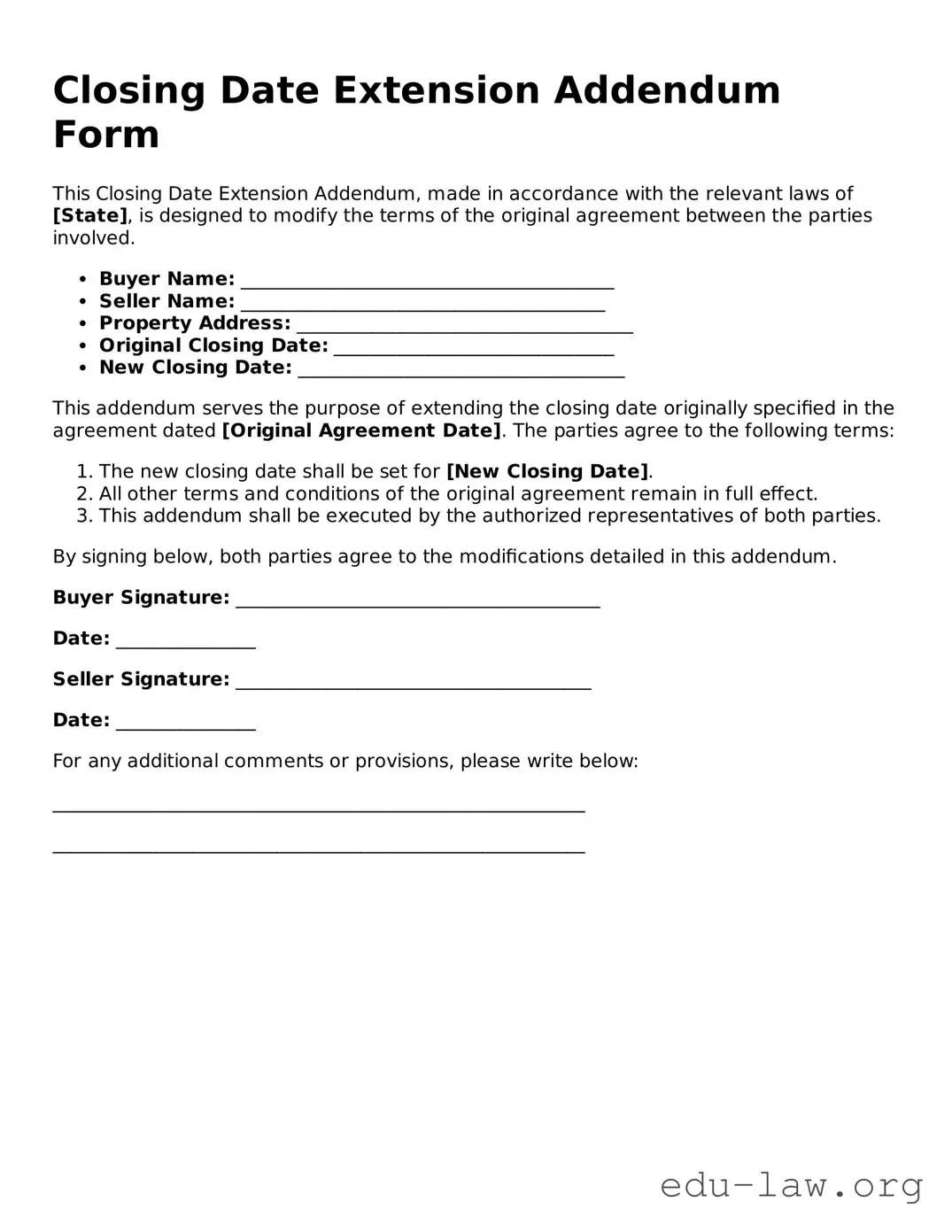What is a Closing Date Extension Addendum Form?
The Closing Date Extension Addendum Form is a document used in real estate transactions to officially extend the closing date of a sale. This form helps both buyers and sellers agree upon a new deadline, reducing confusion and ensuring that all parties are on the same page regarding the timing of the sale. It may be necessary due to various reasons, such as delays in financing, property inspections, or other contingencies that have not yet been resolved.
When would I need to use this form?
This form becomes useful when the original closing date specified in the purchase agreement cannot be met. If either party believes they will need more time—due to issues like repair delays, financing complications, or other unforeseen circumstances—then this addendum becomes necessary. Utilizing the form helps formalize the extension and protects the interests of both parties.
Who can initiate a closing date extension?
Either party involved in the transaction—the buyer or the seller—can initiate a request for a closing date extension. Communication between the parties is essential. It is advisable to reach an agreement on the need for an extension before completing the form, as both parties must consent to the new closing date.
How do I fill out the form?
Filling out the form requires identifying the original closing date, the newly agreed-upon closing date, and obtaining signatures from both parties. Accurate information is crucial. The form typically includes areas for both parties to provide their names, addresses, and contact information, as well as any necessary details about the property involved in the transaction. Clear communication is key to ensuring accuracy.
Is the Closing Date Extension Addendum Form legally binding?
Yes, once both parties have signed the Closing Date Extension Addendum Form, it becomes a legally binding agreement. This means that both the buyer and the seller are obligated to adhere to the new closing date set forth in the addendum. However, it is always advisable to review any agreements with a legal professional to ensure understanding and compliance.
What happens if one party does not agree to the extension?
If one party does not agree to the extension, the original closing date will remain in effect. In such cases, it is important to discuss and resolve any underlying issues that may be delaying the process. If an agreement cannot be reached, either party may face consequences, such as potential cancellation of the agreement or legal disputes, depending on the terms of the original contract.
Is there a limit to how many times I can extend the closing date?
There is no hard and fast rule regarding the number of extensions you can request, but it is important to approach the situation carefully. Each request for an extension should be justified and reasonable. Repeated extensions may raise red flags and create suspicion or concern for the parties involved. Therefore, open communication and transparency are essential.
How is the new closing date communicated to involved parties?
The new closing date should be communicated clearly and promptly to all involved parties. Once the Closing Date Extension Addendum Form is completed and signed, copies should be distributed to all stakeholders, including real estate agents and lenders. This helps ensure that everyone is aware of the updated timeline and can make any necessary adjustments.
Can I negotiate terms related to the extension in the addendum?
Yes, it is possible to negotiate additional terms related to the extension within the addendum. This might include factors like changes to the earnest money deposit, the responsibility for any potential costs incurred due to the delay, or other considerations that may arise from the extended timeline. Both parties should discuss and agree to any changes in writing to ensure clarity and mutual understanding.
What should I do if I have further questions regarding the use of this form?
If you have further questions about the Closing Date Extension Addendum Form or its implications, it is always wise to consult with a qualified real estate attorney or a knowledgeable real estate professional. They can provide guidance that is tailored to your specific situation, helping you navigate any complexities that may arise during the transaction.
